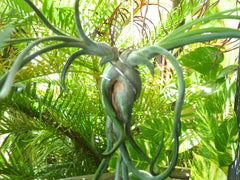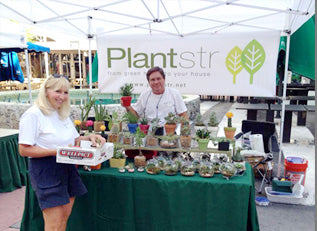Introducing Plantstr Watercolors – custom prints of your favorite Tillandsia Air Plants
As Tillandsia Air Plant lovers, we all look forward to “the bloom”. A time when our favorite air plants display their very best form – exquisite color and awesome flowers. Unfortunately, this is doesn't happen as often as we would like – and the blooms typically don’t last very long, which is one reason why we collect so many different varieties.
So, as an artist and designer, I started creating my Plantstr Watercolor Collection.






I’ve been able to capture the exquisite beauty of air plants at their peak of brilliance, and can now share that moment in watercolor prints in various sizes, either flat or framed, as well as canvas wrapped prints, note cards and other goodies for your home and office. These make memorable gifts for the Tillandsia lovers in your life.
You can place an order here (http://www.plantstr.net/collections/tillandsia-air-plant-watercolor-collection) for 8”x10” watercolor prints. These are individually printed on 300gsm Acid-Free, Cold Press Watercolor Paper.
Other sizes of Prints and Stretched Canvas Prints – with and without frames, as well as a great collection of customized goods and wearable’s can be purchased at: www.society6.com/plantstr.
PLEASE NOTE: Interior Designers- please contact me for additional sizes, finishes and framing options up to 30”x40”. Perfect for Restaurants, Hotels and Retail.
Les@Plantstr.net
Interesting Facts About Air Plants
Air plants are part of the Tillandsia family and they come from the tropics. The main cool fact about them is that they get their name from their capability of drawing all the nutrients and water that they need directly from the air (no soil is needed). Because of the way they feed, these plants can be hanged on fences, wires, or any structure you have indoors and outdoors. Some long arms that look like roots help these plants to attach themselves anywhere.
More than five hundred varieties of air plants exist in the world, spread naturally across Central America, West Indies and South America. These plants are different than regular plants because they don't have any typical roots, leaves or stems. The air plants can turn red and produce yellow-purple tubular flowers during the bloom cycle. In order to thrive, the plants need bright light from the sun, but the light needs to be diffused. In addition to misting once or twice a week, monthly soaking in water is beneficial for complete hydration. You can leave the plants to hydrate for a few minutes or for a few hours, depending on how much water they seem to need. Let them dry out before putting them back into your container.
For hydration, you should use bottled water or tap water from which the chemicals have evaporated over night. You will have to immerse the whole plant in water. The only type of water that shouldn't be used on air plants is distilled water, as it can kill them. Air plants are very popular today because they are beautiful, can live in any environment and don't occupy a lot of space.
The closest "relative" of air plants is the pineapple. You can find a lot of air plant varieties for sale today because they don’t need too much care and they can be combined with various decorative items.
Types Of Air Plants: Ionantha And How To Grow Them
Air plaints, otherwise known as Tillandsia, are not only colorful and easy to care for, but also do not cost a lot and are small and easy enough to grow any where indoors. This makes air plants great for small apartments.
The majority of airplants come from Central and South America, but they are also found in California, Texas and a few other areas of the USA. The reason the name given is air plant is because of how they feed – they get their hydration and nutrients from the air.

When buying Ionantha air plants online, the majority of them will be 1.5" to 2” high at the time they are purchased, but will grow about another inch during maturity.
Ionantha's are some of the easiest to grow, reproduce and maintain. Check out our other blogs to learn more about air plant maintenance.
Air Plants, The Reasons Why They're Best For Non Green Thumbs
Plants are beautiful; they are a symbol of life and beauty in its purest form. Having plants within the house is even better as they give you a sense of being in touch with nature and the peace that come with that even when you are inside your house. However, most plants require a lot of attention, finding the right vase; watering them regularly otherwise they will die. All this may be a bit overwhelming and if you love plants but do not trust yourself in remembering to tend to them regularly, then air plants may just be the plants for you.
Air plants, also known as Tillandsia, are a branch of the Bromeliad family of plants that DO NOT require soil in order to thrive, but rather get most of their nutrients and water from the air. Their leaves are designed in such a way that they absorb all the nutrients needed for their survival-hence the name air plants. In nature, they require a surface on which they can attach themselves using their roots, mostly trees, rocks, walls and other plants, and do not take any nutrients from the host.
Air Plants thrive naturally in tropical, warm weather conditions. However, there are over 550 species of the plant and their needs may vary. Most air plant leaves are thin, tubular shaped and change color from green to red when they are about to produce their gorgeous purple/yellow flowers.
Air plants are quickly becoming popular. Given that they come in many varieties, you need to conduct some research in order to be able to make a decision as to what will grow best for your needs. The Internet is a good place to start and has pictures of the various types of air plants.
So after selecting the air plants you prefer for your collection or design, you need to know how to take care of them. They do not require as much attention as the other ordinary plants. but if neglected for too long will die. It is important to place the plants where they are getting a good amount of filtered sunlight, but not baking in direct sunlight.
A little misting is necessary once or twice a week, as is a monthly soaking bath. This will go a long way in providing the extra moisture air plants need inside a home. Fertilized in liquid low-nitrogen fertilizer, such as that used for orchids, on a quarterly schedule would help give them extra nutrients. Diluted the fertilizer to 1/4 strength and either add to your misting bottle or to your soaking bath. Air plants cannot survive in cold climates and therefore avoid keeping in temperatures below 50 degrees. Most importantly, the plant is totally dependent on air to live, hence ensure there is a lot of free flowing air around it. DO NOT bury in soil or other materials that absorb water. Do all this and your air plant will grow beautifully. Buying air plants from a reputable dealer is the best option, especially if you do not know much about air plants. This is because they have already made the decision concerning what species survive the best and would provide you with first hand advice on how to care for the plants. After all, we are part of nature.
How Do Air Plants Reproduce

After flowering, most air plants start the reproduction cycle by producing “pups”, which typically start growing around the base of the air plant. When the "pups" grow to about 1/2 size of the parent, you have 2 cool options:
1) remove the "pup" and let your new plant grow, flower and reproduce again
2) leave the "pup" attached, and you'll soon have a beautiful cluster growing, which will continue to flower and produce new "pups"
It's very enjoyable to watch the growing cycle. Each specie of air plant reproduces somewhat differently. if you have kids, this is very educational and fun to watch. PLUS... you are purifying the air you breath. Air plants are one of the best natural air cleaners of all plant species.
Did you know that some Air Plants are fragrant when in bloom?


Some Air Plants not only are beautiful to look at, but also release an intoxicating fragrance when in bloom. The yellow flowers of the Tillandsia Crocta and the Tillandsia Duratii are two of our favorites.
The delicate yellow flowers of the Tillandsia Crocta have one of the sweetest fragrances in all the bromeliad world. And the grape-scented Tillandsia Duratii has pretty violet-colored flowers that emit an amazing Concord grape odor for up to a month.
There are only about 30 of the 500 varieties of Air Plants that are fragrant. If you would like to purchase one of these, please visit our Air Plant store to see our current inventory. http://www.plantstr.net/collections/air-plants








 Plantstr is about making you feel good about yourself and the place you live. Beautiful, exotic flowering
Plantstr is about making you feel good about yourself and the place you live. Beautiful, exotic flowering 



